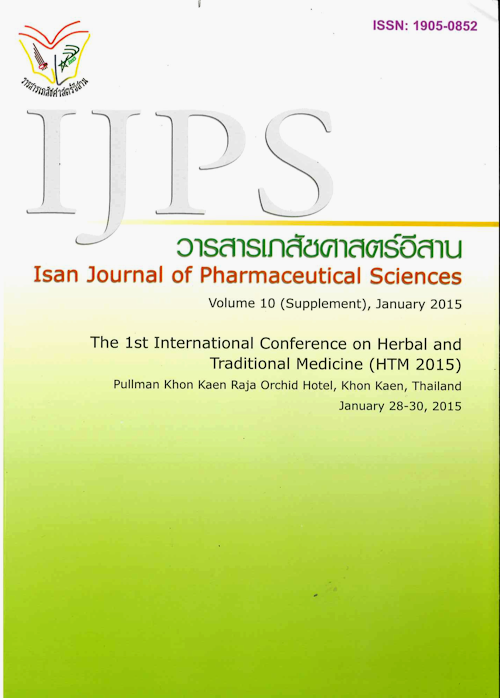Encapsulation of Anthocyanin from Mamao (Antidesma thwaitesianum Mull. Arg.) by using Freeze Dry Technology
Main Article Content
Abstract
which is one of the most important group of water-soluble and vascular pigment in nature. This
phytochemical is interested in food and health products, due to the wide range of biological activities
including antioxidant, anti-infl ammatory and activation of immune system. However, the used of
anthocyanin from fruit extract had low stability during processing and storage. The goal of this research
was to prepare and characterize the encapsulated anthocyanin from Mamao by freeze dry technology.
Methods: The fruit extract (1.0 g) was added to 89 g of aqueous solution of 10 % maltodextrin (Wall
material I) and 10% combination between maltodextrin and gum arabic (Wall material II). The mixture
was homogenized and frozen using freeze dryer. The physicochemical properties were characterized
on scanning electron microscope, encapsulation effi ciency (EE), encapsulation yield (EY), pH, color,
moisture content and solubility in water and ethanol. Results: The results demonstrated that the total
anthocyanin content could be loaded to the wall materials and EE was in the range of 90 – 100 %.
The EY was in the range of 90 – 100 %, indicating the encapsulation process did not infl uence on the
loss of active ingredients. Conclusion: The encapsulation processes of fruit extract with suitable wall
material could be applied to create a new innovation for modifi es the effi cacy and stability of fruit extract.
The effi cacy and stability of encapsulated powders in accelerated condition (40 0C, 75 % RH. for 6
months) will be further investigated.
Article Details
In the case that some parts are used by others The author must Confirm that obtaining permission to use some of the original authors. And must attach evidence That the permission has been included
References
Dewanto V, Wu XZ, Adom KK, et al. Thermal processing enhances the nutritional value of tomatoes by increasing total antioxidant activity. J Agri Food Chem 2002a; 50: 3010–3014.
Dewanto V, Wu XZ, Liu RH. Processed sweet corn has higher antioxidant activity. J Agri Food Chem 2002b; 50: 4959–4964.
Frias J, Miranda ML, Doblado R, et al. Effect of germination and fermentation on the antioxidant vitamin content and antioxidant capacity of Lupinus albus L. var. Multolupa. Food Chem 2005; 92(2): 211–220.
Giusti MM, Wrolstad RE. Characterization and measurement of anthocyanins by UV-Vis spectroscopy. Current protocols in Food Analytical Chemistry Unit F1.2 John Wiley & Sons, Inc; 2001.
Harrison DEF. Mixed-cultures in industrial fermentation processes. Adv Appl Microbiol 1978; 24: 129–64.
Hassan MR, Alam KD, Mahjabeen S, et al. Free radical scavenging potential of methanol extract of Smilax roxburghiana. Pharmacologyonline 2011; 2: 774–783.
Hertog MGL, Feskens EJM. Dietary antioxidant fl avonoids and risk of coronary heart disease the Zutphen Elderly Study. Lancet 1993; 342: 1007-1011.
Kang KS, Kim HY, Pyoand JS, et al. Increase in the free radical scavenging activity of ginseng by heat-processing. Bio Pharm Bull 2006; 29: 750–754.
Kawaii S, Lansky EP. Differentiation-promoting activity of pomegranate (Punica granatum) fruit extracts in HL-60 human promyelocytic leukemia cells. J med Food 2004; 7: 13–18.
Lee IH, Hung Y-H, Chou C-C. Solid-state fermentation with fungi to enhance the antioxidative activity, total phenolic andanthocyanin contents of black bean. Int J Food Microbiol 2008; 121(2): 150–156.
Li X, Chen C. Systematic evaluation on antioxidant of magnolol in vitro. Int Res J Pure Appl Chem 2012; 2(1): 68–76.
Martins S, Mussatto SI, Martinez-Avila G, et al. Bioactive phenolic compounds: Production and extraction by solid-state fermentation. A review. Biotech Adv 2011; 29(3): 365–373.
Mathew S, Abraham TE. Studies on the antioxidant activities of cinnamon (Cinnamomum verum) bark extracts, through various in vitro models. Food Chem2006; 94(4): 520–528.
Mendoza ML, Merin MG, Morata VI, et al. Characterization of wines produced by mixed culture of autochthonous yeasts and Oenococcus oeni from the northwest region of Argentina. J Ind Microbiol Biotechnol 2011; 38: 1777–1785.
Miller NJ, Rice-Evans CA. Factors infl uencing the antioxidant activity determined by the ABTS+ radical cation assay. Free Radical Res 1997; 26(3): 195–199.
Mousavi ZE, Mousavi SM, Razavi SH, et al. Fermentation of pomegranate juice by probiotic lactic acid bacteria. WorldJ Microb Biot 2011; 27: 123–128.
Naczk M. Shahidi F. Phenolics in cereals, fruits and vegetables: Occurrence, extraction and analysis. J PharmBiomed 2006; 41(5): 1523–1542.
Nicoli MC, Anese M, Parpinel M. Infl uence of processing on the antioxidant properties of fruits and vegetables. Trends Food Sci Tech 1999; 10: 94–100.
O’Toole DK, Lee YK. Fermented Foods. Microbial Biotechnology: Principles and Applications (ed. Lee YK.), New Jersey: World Scientifi c; 2003. 201–256.
Seyram SK, Yaovi A, Simplice KD, et al. Study of pineapple peelings processing into vinegar by biotechnologies. PakistanJ Biol Sci 2009; 12: 859–865.
Shimada K., Fujikawa K, Yahara K, et al. Antioxidative properties of xanthan on the autoxidation of soybean oil incyclodextrin emulsion. J Agr Food Chem1992; 40: 945–948.
Simic MG. Mechanisms of inhibition of free-Radical. Processed In mutagenesis and carcinogenesis. Mutation Res 1988; 202: 377-386.
Singleton VL, Rossi JA. Colorimetry of total phenolic with phosphomolibdic–phosphotungstic acid reagents. J Enol Vitic1965; 16: 144–158.
Sun Y. Free radicals, antioxidant enzymes and carcinogenesis. Free Radical Biol Med1990; 8: 583–99.
Temudo MF, Muyzer G, Kleerebezem R, et al. Diversity of microbial communities in open mixed culture fermentations: impact of the pH and carbon source. Appl Microbiol Biotechnol 2008; 80: 1121–1130.
Tetsuya K, Masao K. Effi cient production of acetic acid from glucose in a mixedculture of Zymomonas mobilis and Acetobacter sp. J Ferment Bioeng 1996; 81(1): 42–46.
Tomaino A, Cimino F, Zimbalatti V, et al. Infl uence of heating on antioxidant activity and chemical composition of some spice essential oils. Food Chem 2005; 89: 549–554.
Torino MI, Limon RI, Martinez-Villaluenga C, et al. Antioxidant and antihypertensive properties of liquid and solid state fermented lentils. Food Chem 2013; 136(2): 1030–1037.


